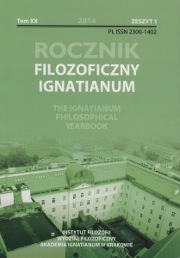René Descartes: Dancing and Mustering Substances
Abstract
This article addresses two of the fundamental issues present in the philosophy of René Descartes (1596--1650): (i) his division into thinking and spatially extended substances, together with both substantive and methodological aspects of his understanding of their character as a unity, and (ii) his conception of the human body as a machine. I shall illustrate these topics here using the example of Descartes' own military training in the army of the Prince Maurice of Nassau and, as a contrast to this, also his work in another area of highly trained human activity - namely, human dance. In speaking about dance I will not differentiate between its diverse types (individual, dancing with a partner, group dances, ritual, folk, Latin American, typical or non-typical style, mixed, etc.). I am only interested in dance as a form of continuous, rule-governed spatial movement by human subjects. I also have pretty much the same thing in mind when speaking about military training, that is, a form of continuous, rule-governed spatial movement on the part of its protagonists.
References
Classen C (2012), "The Deepest Sense. A~Cultural History of Touch" Chicago University of Illinois Press.
Damasio A (1994), "Descartes Error: Emotion, Reason and the human Brain" London The Penguin Press.
Dennett D (1991), "Consciousness explained" Boston Little, Brown and Company.
Descartes R (1967--1974), "Oeuvres de Descartes" Paris Vol. V J. Vrin.
Descartes R (2005), "Świat albo Traktat o~świetle" Kraków Aureus.
Descartes R (1901), "Meditations on First Philosophy (1641)", In The Method, Meditations and Philosophy of Descartes. New York , pp. 205-280. Tudor.
Eltis D (1998), "The Military Revolution in Sixteenth-Century Europe" New York St. Martin's Press.
Evans AW (2012), "Safe Operations of Unmanned Systems for Reconnaissance in Complex Environments-Army Technology Objective (SOURCE ATO) Field Experimentation Observations and Soldier Feedback" Aberdeen Army Research Laboratory MD 21005.
Fischer M (2006), "Wenn Substanzen tanzen", In Philosophie des Tanzes. Freiburg Freiburg im Breisgau , pp. 98-113. Fördergemeinschaft wissenschaftlicher Publikationen von Frauen.
Heuser B (2010), "The Evolution of Strategy. Thinking War from Antiquity to the Present" Cambridge Cambridge University Press.
Hoffman P (1986), "The Unity of Descartes's Man", The Philosophical Review. (95(3)), pp. 339-370.
Lawrence DR (2009), "The Complete Soldier: Military Books and Military Culture in Early Stuart England, 1603--1645" Leiden Koniklijke Brill NV.
McMullen ET (2002), "The Origin of Descartes' Mechanical Philosophy", Georgia Journal of Science. (60(2)), pp. 127-143.
Parker G (2005), "Dynastic War 1494--1660", In The Cambridge History of Warfare. Cambridge , pp. 148-166. Cambridge University Press.
Schechtman JB (1956), "The Life and Times of Vladimir Jabotinsky: Rebel and Statesman" New York T. Yoseloff.
Ueberweg F (1993), "René Descartes", In Grundriss der Geschichte der Philosophie. Die Philosophie des 17. Jahrhunderts. Basel Vol. 2, pp. 273-348. Schwabe and Co..
van Orden K (2005), "Music, Discipline and Arms in Early Modern France" Chicago University of Chicago Press.
Łukasiewicz J (1910), "O~zasadzie sprzeczności u~Arystotelesa. Studium krytyczne" Warszawa Polska Akademia Umiejętności.
(2007), "Princess Elisabeth of Bohemia and René Descartes. The Correspondence between Princess Elisabeth of Bohemia and René Descartes" Chicago University of Chicago Press.
The Yearbook only accepts materials for publication that are free of all conflicts of interest, and that in no way involve conflicts over authorship, copyright, etc. The Editors will take action against any cases of plagiarizing, ghostwriting1, guest/honorary authorship2, etc. Where co-authored work is concerned, the Author listed first is expected to take responsibility for the submission, and is required to make clear the contributions of all of the Co-Authors involved. In the event of the publication owing its existence to funding dedicated to this purpose, this fact should be made clear: e.g. in any note of thanks/acknowledgement, or in a footnote, etc. Explicit notification should be given of any form of reprinting, with the appropriate evidence of permission to publish being furnished as required. Any impropriety on the part of Authors/Reviewers risks exposing them to appropriate responses from the relevant institutions.
______
1 This term refers to instances of a person who has made an essential contribution being omitted from the list of authors, or from notes conveying gratitude and/or acknowledgement.
2 This occurs when a person who has made either an insignificant contribution or no contribution at all nevertheless appears on the list of authors.





